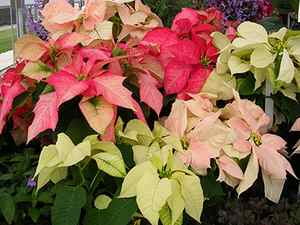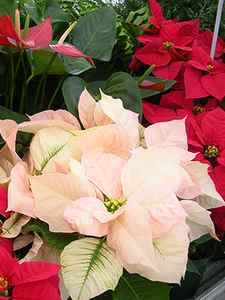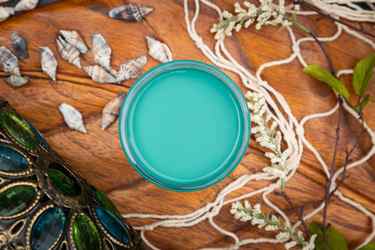Poinsettias are the most popular plants for the holiday season. Photo courtesty of Marc Frank, UF/IFAS. All rights reserved.
Plant Profile: The Poinsettia
Perhaps no plant has as stronger connection to the holiday season than the poinsettia. The brightly colored shrub has been a feature of Garden floral shows for more than a century, and remains an annual star of the Gardenland Express Holiday Flower and Train Show.
The poinsettia, Euphorbia pulcherrima, is a member of Euphorbiaceae, the spurge family. Euphorbiaceae is a large and highly diverse family that includes trees, shrubs, herbaceous plants and succulents. Missouri Botanical Garden taxonomist Dr. Gordon McPherson studies Euphorbiaceae and published six new species in 2017.
Poinsettias are prized during the holiday season for their large, colorful “flowers,” but what appear to be red or white petals are actually bracts, or modified leaves. Like other members of Euphorbiaceae, poinsettia flowers are unisexual, meaning that they only contain male or female parts. These tiny flowers are clustered together into a group called a cyathium, which mimics a single bisexual flower.
The poinsettia is named for Joel Roberts Poinsett, our country’s first ambassador to Mexico. Poinsett brought the plants to the U.S. in the 1820s. The scientific name, Euphorbia pulcherrima, means “very beautiful.”

Poinsettias are native to the low and mid-elevation tropical deciduous forest of southern Mexico. Wild poinsettias grow as small trees or tall flowering shrubs. Since these are tropical plants, poinsettias are very frost tender. In northern climates, even brief exposure to freezing temperatures, such as a walk from the store to the car, can damage leaves.
Poinsettias are the most widely grown of all shrubby euphorbias with over 100 varieties available on the market. They represent about 85 percent of potted plant holiday season sales. The U.S. exports about 90 percent of the world’s poinsettias, which are grown commercially in greenhouses in all 50 states, producing over 60 million plants for sale. With the proper maintenance and care, these plants can last year-round.
Are Poinsettias Poisonous?
Unlike many members of Euphorbia, the milky sap within poinsettia leaves and bracts is not lethally toxic. Although some people or pets may experience upset stomachs if they ingest the sap, this often does not require a visit to the doctor. In fact, research shows that a person would need to eat hundreds, possibly thousands of poinsettia leaves (about 500 leaves for every 50 pounds) to receive a toxic dose of the latex sap. There may even be some medicinal qualities within the sap of a poinsettia. It is documented that parts of the poinsettia were used by the Aztecs to produce medicine and dye.
The Garden produces nearly one thousand poinsettias each year in our production greenhouses. Poinsettias are grown according to the number of plants requested based on the design by the floral display supervisor. The number of poinsettias is approved by January 1, giving Greenhouse staff six months to prepare the greenhouses and order poinsettias for the show.

(Name) tends to a young poinsettia plant in the greenhouse. Photo by Bethany Ottens.

A Garden staffer tends to poinsettias in the greenhouse, circa 1953. Photo from MBG Digital Archives.
Before the poinsettia stems and pinch plants arrive, Greenhouse staff spend a week cleaning and sterilizing the designated greenhouse, tools, and pots to prevent diseases and pests from damaging the new crop. Single stem cuttings come into the Greenhouse around the 4th of July. The second shipment of pinched plants arrives two weeks after. Throughout their growth, the poinsettias are placed on an integrated pest management (IPM) program. A combination of beneficial insects, such as parasitic wasps, and biopesticides is used to reduce pests and prevent outbreaks.
The poinsettias are set on a strict schedule from the day they arrive to when they are placed in the show. The greenhouse is kept at 75 degrees during the day and 67 degrees at night. First, Greenhouse staff focus on promoting strong root growth. Once poinsettias are rooted, Greenhouse staff fertilize the plants to promote vegetative growth. Vegetative growth occurs until late October, then staff begin to pinch off the top of the plants to encourage lateral branching.
To promote coloring of bracts, poinsettias need 12 hours of full darkness. All lights within and around the poinsettias’ greenhouse must be turned off at night starting in mid-September. Color begins to show in the bracts around Halloween. The poinsettias come in all different shades of red, white, pink, and orange.
The Greenhouse produces around one thousand poinsettias behind-the-scenes. Most go in the Gardenland Express. Some are held back as replacements. Others are used in displays in Center for Home Gardening, Linnean House, and Temperate House.

History of Poinsettia Displays at the Garden
The Garden has been showcasing poinsettias for more than a century. The original Floral Display House opened in 1915, and hosted an annual poinsettia show until the 1970s. The plant was also used prominently for holiday displays in the Climatron. The poinsettia is now an integral part of the Gardenland Express Holiday Flower and Train show in the Orthwein Floral Display Hall.
This slideshow requires JavaScript.
Jennifer Laquet, Interpretation Specialist
Cassidy Moody, Digital Media Specialist
It is named for the person who introduced it to the United States
The poinsettia was brought to the United States from Mexico around 1828 by Joel Roberts Poinsett. An avid gardener and amateur botanist, Poinsett was serving as a congressman from South Carolina when he was appointed as the first US Minister to Mexico (a position that he held from 1825 to 1829). While in Mexico, Poinsett observed this species flowering and sent plants back to his greenhouse in Charleston. Until that time, this species was unknown outside of its native range of Mexico and Guatemala, where it was referred to as flor de nochebuena (Christmas Eve flower). Once introduced to the U.S., it quickly gained the common name poinsettia, but is also known by many other common names including Christmas flower, Christmas star, lobster plant, painted leaf, and Mexican flame leaf.
The whorl of brightly colored structures we think of as flower petals are actually bracts — modified leaves, which function to attract pollinators to the relatively small and inconspicuous actual flowers at the center. Compare a bract with one of the leaves and you will notice they are quite similar in structure, but are just differently colored. In wild poinsettias, the bracts are typically bright red, but horticulturists have now bred varieties with bracts in varying shades of white, pink, purple, orange, and yellow.
Poinsettias form flowers in response to day length and temperature
Poinsettias do not produce flowers year-round. Instead, this species initiates flower buds in winter when the nights are longer than the days. While known as “short day plants,” it is actually the exposure to darkness that is critical to the formation of colorful bracts and flower buds. Dark periods of 11 hours, 45 minutes will initiate flowers in most poinsettia varieties, but initiation is most rapid at 14–14.5 hours of darkness. Temperatures above 79 degrees can delay flower initiation, as can exposure to outdoor lights. In order to have poinsettias ready to sell by Thanksgiving, commercial poinsettia growers need to create ideal conditions in their greenhouses in late September or early October. They do this by pulling light-excluding fabric over their nursery benches each afternoon to achieve the required period of darkness and maintain their greenhouses at 62-68 degrees.
This species has a reputation for being extremely poisonous. While there is little doubt that the milky latex of poinsettias can cause irritation to the skin, eyes, mucus membranes, or when consumed, to the digestive system, poinsettia is apparently one of the less toxic species of Euphorbia.
According to Toxic Plants of North America¹, “Most accounts of poinsettia poisoning are unconfirmed and not consistent with experimental evidence and carefully evaluated clinical experiences. Analysis of 22,793 cases of reported human exposures to poinsettia revealed that 93.3% were in children, that there were no fatalities, and that in 92.4% there were no signs of adverse effects.”

Poinsettias have been bred for bracts of many different colors. Photo courtesy of Marc Frank, UF/IFAS. All right reserved.
Poinsettias are a high-value crop
According the USDA, poinsettias are the second largest-selling flowering potted crop in the country (orchids are the biggest seller). In 2018, U.S. potted poinsettia sales totaled $149 million.
Marc S. Frank
Extension Botanist
UF/IFAS Plant Identification and Information Service
University of Florida Herbarium
Also on Gardening Solutions
1. Burrows, George E. and Ronald J. Tyrl. 2013. Toxic Plants of North America, 2nd ed. Wiley-Blackwell, Hoboken, NJ.

- About This Site
- Disability Services
- Privacy Policy
- Regulations
- Contact Us
- Email the Webmaster
- © 2021 University of Florida, Gainesville, FL 32611
- This page uses Google Analytics (Google Privacy Policy)
- Last modified: December 13, 2019




